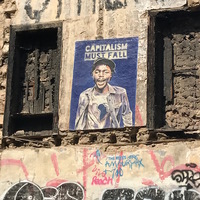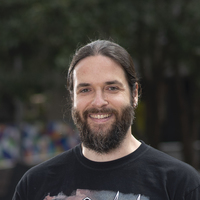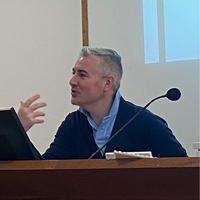Books by Arnaud Gerspacher
The Owls Are Not What They Seem is a selective history of modern and contemporary engagements wit... more The Owls Are Not What They Seem is a selective history of modern and contemporary engagements with animals in the visual arts and how these explorations relate to the evolution of scientific knowledge regarding animals. Arnaud Gerspacher argues that artistic knowledge presents a valuable supplement to scientific knowledge when it comes to encountering and existing alongside nonhuman animals and life worlds.
Papers by Arnaud Gerspacher
October, 2022
I would like to thank Hal Foster for his helpful and incisive feedback on this text. I am also gr... more I would like to thank Hal Foster for his helpful and incisive feedback on this text. I am also grateful for Adam Lehner's many valuable comments and suggestions. Thanks to Debra Riley Parr and Deirdre Madeleine Smith for reading an earlier version of this essay. A portion of this text was presented on the panel titled "'Our Ancestor Was an Animal That Breathed Water'/Non-Human Beings and Art of the Anthropocene" at the College Art Association annual conference in 2021.
transcript Verlag eBooks, Dec 31, 2024
October Journal, 2022
* I would like to thank Hal Foster for his helpful and incisive feedback on this text. I am also ... more * I would like to thank Hal Foster for his helpful and incisive feedback on this text. I am also grateful for Adam Lehner's many valuable comments and suggestions. Thanks to Debra Riley Parr and Deirdre Madeleine Smith for reading an earlier version of this essay. A portion of this text was presented on the panel titled "'Our Ancestor Was an Animal That Breathed Water'/Non-Human Beings and Art of the Anthropocene" at the College Art Association annual conference in 2021.

Olfactory Art and the Political in an Age of Resistance (Routledge), 2021
A myth persists that Vincent van Gogh fed on yellow tubes of paint in order to alter his mood. Ho... more A myth persists that Vincent van Gogh fed on yellow tubes of paint in order to alter his mood. However unlikely these stories may be, there is little question that the painter suffered from serious digestive ailments. This being the case, in light of current knowledge of the gut-brain axis and its role in modulating our cognitive and emotional lives, how might art historians undertake a sort of psychointestinalysis of his work? While it would be difficult to take these microbiotic depths into interpretive account (how would they even be coded?), his digestive ailments unavoidably informed his artistic mind to some degree. For a more recent example at the level of the audience reception, how might we interpret participatory installations involving foods and their affectivity on visitors' gut microbiomes? 1 Making these questions even more complicated is the fact the gut microbiome is increasingly situated in communion not only with the brain but also with the other microbiomes of the body-nasal, pulmonary, dermal. Hence what is at stake is the subject as holobiome (Bienenstock, Kunze, and Forsythe 2018). It is an ecological theory of our insides as always in negotiation with the ecological realities of our outsides. Any neuroarthistory, a method that tends to restrict its concerns to the visual brain and the cognitive, is incomplete without this wider affectional aggregate of digestive, endocrinological, and pneumatic being. 2 This is additionally a creaturely theory. It is ethological in the sense Deleuze and Guattari use the term in their Spinozian theory of becoming-animal-of knowing "what a body can do" (or cannot do) in its "individuated multiplicity" (Deleuze and Guattari 2007, 254, 256). While our microbiomes allow us to live, breath, and consume, they also keep us grounded as interdependent and multispecies creatures. In our teaming reliance on all sorts of bacteria, fungi, and other microbiota-which alone qualify us as individuated multiplicities-we always run the risk of having this dependence instrumentalized in some way. In other words, using the anthropologist Heather Paxson's coinage, we have always lived in a microbiopolitics (Paxson 2008). Like all other holobiomic creatures, we find ourselves caught between biopolitical control and our ability (or inability) to escape and live freely-or, at least, to live within pressures and constraints in a more or less comfortable way-and part of understanding subjectivity through our microbiomes is sniffing out how ideology can come in through the mouth and nose, implicating a multispecies set of tongues and nostrils. But maybe smelling, chewing, and digesting also offer forms of resistance and critique. "I smell a rat" or "going with your gut" are kynical forms of street-smart attunement that can see through academic, neoliberal, and humanist pretensions. I use the word "kynical" in Peter Sloterdijk's sense, which performs critique through
The Routledge Companion to Biology in Art and Architecture, 2016
Pacific Northwest College of Art, 2013











Uploads
Books by Arnaud Gerspacher
Papers by Arnaud Gerspacher